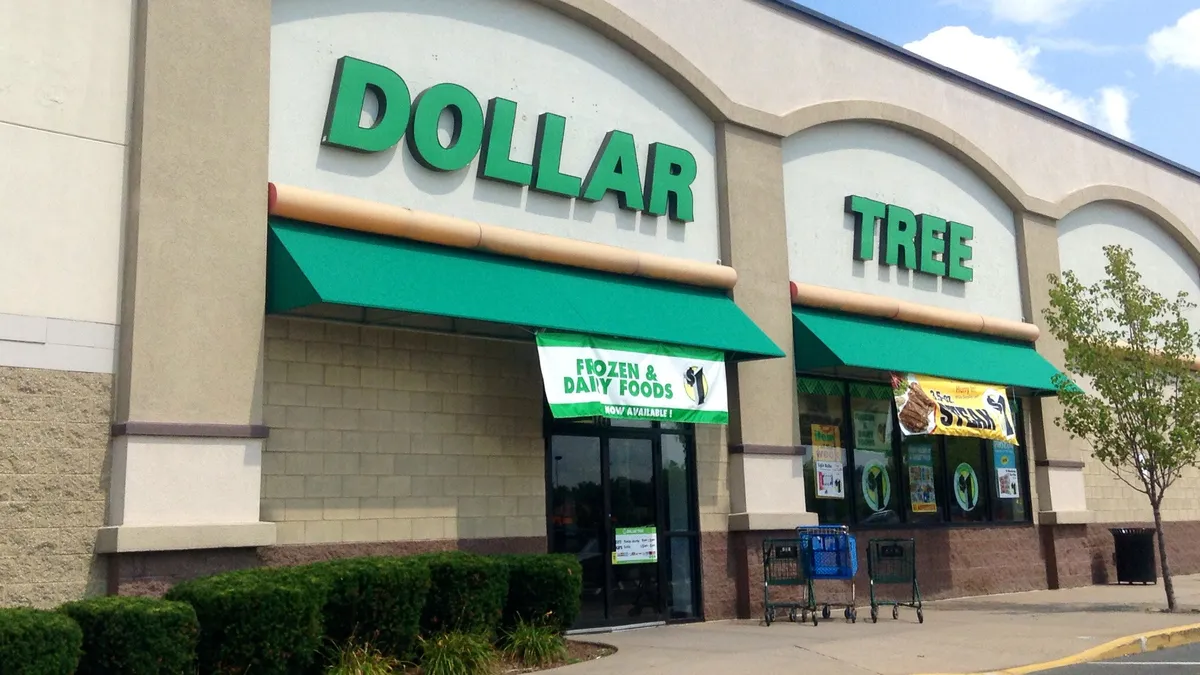Dive Brief:
-
Dollar Tree Inc. on Thursday reported that second quarter consolidated net sales rose 5.7% to $5.28 billion compared to Q2 last year, besting the Zacks Consensus Estimate of $5.23 billion. Diluted earnings rose 36.1% to 98 cents per share, up from to 72 cents per share in the prior year's quarter and well above the Zacks Consensus Estimate of 87 cents per share. Earnings also beat the company’s own guidance for 80 cents to 88 cents per share.
-
Enterprise same-store sales rose 2.4%, driven by increases in comparable transaction count and average ticket, according to a company release. Same-store sales for the Dollar Tree banner rose 3.9% — its 38th consecutive quarter of positive same-store sales — while same-store sales for the Family Dollar banner increased 1%, the company said.
-
The company raised its guidance for the year, now saying it expects net sales ranging from $22.07 billion to $22.28 billion, up from its previous estimate of $21.95 billion to $22.25 billion. Driving the upgrade are Dollar Tree’s estimates for same-store growth in the “low single-digits” and square footage growth of 3.9%, according to the release.
Dive Insight:
Dollar Tree appears to be shrugging off Walmart’s rejuvenated price competition and online ambitions, as the dollar retailer remains — despite increased online efforts — largely focused on its brick-and-mortar strategy.
CEO Bob Sasser told analysts Thursday that the company anticipates it will add to its already large fleet of more than 14,500 Dollar Tree and Family Dollar locations. “We continue to grow the store base. This year, we’re opening 650 new stores, and we have years of growth ahead,” he said, according to a conference call transcript from Seeking Alpha. “We have identified an opportunity for 26,000 stores across North America.”
That may be a bit ambitious, according to GlobalData Retail analyst Anthony Riva. “[T]here is more headroom for growth, although we think the company's projections are overly optimistic,” he said in a note emailed to Retail Dive. “We also believe that the return from newer stores is more limited, if only because there is increasing saturation as other dollar and discount formats expand.”
The two banners continue to operate in somewhat different ways, which executives say presents a singular growth opportunity. Sasser calls Family Dollar’s 8,000 stores “your neighborhood discount store,” while at the more than 6,500 Dollar Trees, everything is a dollar.
Both depend on lower-income consumers, and Sasser noted that the stores have to be especially ready for customers early in the month, when they have the most money in their pockets. “When times are tough, we are a part of the solution to help that customer make ends meet,” Sasser said. “[W]hen times are better, customers appreciate our convenience and our value. ”
That, plus increasing competition, including from advancing low-cost grocers like Lidl and Aldi, will keep prices down, Riva warned. Walmart has demonstrated its willingness to meet that challenge, and even Amazon this week promised to lower prices at its new Whole Foods unit.
"As much as this may take the edge off growth, we believe that Dollar Tree is showing it can hold its own," Riva said. "Unfortunately, it does not appear that the competition on price will ease up. We believe it will intensify over the rest of this year, especially as Lidl expands and other players respond to the threat it poses.”














